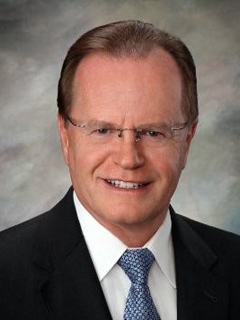The power of transparency
Helping an energy delivery company transform its rate-case function for the demands of a robust capital investment

Helping an energy delivery company transform its rate-case function for the demands of a robust capital investment
Client
A leading energy delivery company
Industry and Sector
Industrial manufacturing | Energy and chemicals
Primary goal
To establish a rate-case management function within IT
When an acquisition doubles your revenue in your largest market, there are some big numbers at play—especially when you’re a $48 billion CPG company. And the bigger the numbers, the bigger the impact of every strategic and tactical decision you make. You can’t afford to have your visibility clouded and your decision-making hampered by having two disparate financial operations functions each with its own systems, software, and people. So, when a global CPG company found itself in this situation, it called on KPMG to drive fast, smooth, cost-efficient integration of financial operations.
1
and global alignment between cross-functional teams
2
into consolidated spend driving meaningful insights and more proactive decisions
3
the monthly close cycle
4
revenue and sales forecasting
Rate case development is no simple matter for any utility. For our client, responding to the demands of “rate cases,” or the process of seeking rate approvals from regulators and other parties—was about to become significantly more challenging due to a planned capital investment in the tens of billions. Responding to requests from regulatory commissions would put an especially heavy strain on information technology (IT). Knowing the importance of effective rate-case processes in helping to avoid disallowances, our client decided to transform its capabilities. It wanted to respond to regulators efficiently and consistently across its large territory, and position itself as a leader providing transparent, accurate information to stakeholders. To answer critical questions about everything from workflow processes and management models to preparing for an effective launch and promoting full-on engagement, this energy leader turned to KPMG.
Client transformation journey
Acquiring a large organic food and beverage business helped a global CPG company expand its operations and nearly double its revenue in the U.S. However, as with most mergers, the integration posed some challenges. Two disparate IT environments with different accounting and reporting models, separate enterprise resource planning (ERP) systems, and multiple business intelligence (BI) tools required extensive manual intervention and offline data manipulation, preventing uniform reporting and analysis. Data was trapped in silos. Visibility was insufficient. A new CFO and the finance and accounting teams lacked the insight to support effective forecasting and both strategic and tactical decision-making. In a sector as competitive and fast-changing as food products, this company needed to increase visibility quickly.
Acquiring a large organic food and beverage business helped a global CPG company expand its operations and nearly double its revenue in the U.S. However, as with most mergers, the integration posed some challenges. Two disparate IT environments with different accounting and reporting models, separate enterprise resource planning (ERP) systems, and multiple business intelligence (BI) tools required extensive manual intervention and offline data manipulation, preventing uniform reporting and analysis. Data was trapped in silos. Visibility was insufficient. A new CFO and the finance and accounting teams lacked the insight to support effective forecasting and both strategic and tactical decision-making. In a sector as competitive and fast-changing as food products, this company needed to increase visibility quickly.
While this CPG company’s business is spread across two continents (and originates from a number of acquired companies), its financial operations are now centralized and unified. A cloud-based platform extracts and loads data from numerous global sources, then configures and stores it in a central location. Accounting staff across multiple back offices work within a single governance structure and with a single set of streamlined processes, enabling effective reporting and supporting a swift, accurate close. Across the enterprise, visibility is excellent, and insights are at the ready, because analysts can perform real-time calculations and drill down swiftly to the meaning behind the numbers. Unified financial operations helps this $48 billion player predict accurately, plan effectively, and act swiftly—all crucial in a sector where windows of opportunity close as suddenly as they open.
While this CPG company’s business is spread across two continents (and originates from a number of acquired companies), its financial operations are now centralized and unified. A cloud-based platform extracts and loads data from numerous global sources, then configures and stores it in a central location. Accounting staff across multiple back offices work within a single governance structure and with a single set of streamlined processes, enabling effective reporting and supporting a swift, accurate close. Across the enterprise, visibility is excellent, and insights are at the ready, because analysts can perform real-time calculations and drill down swiftly to the meaning behind the numbers. Unified financial operations helps this $48 billion player predict accurately, plan effectively, and act swiftly—all crucial in a sector where windows of opportunity close as suddenly as they open.
There will be more acquisition targets in the company’s future. And with a cloud-based platform, governance framework, and standardized processes in place, integrating financial operations will be a swift, sure process. A successful integration inspired the CFO and global finance team to consider other areas for transformation. From evolving multiple layers of the target operating model within Finance, to jump-starting transformation across other functional areas, a powerful ripple effect began and continues across the enterprise. Having the right tools and processes to support a grander vision driven by meaningful insights will continue to empower positive change.
There will be more acquisition targets in the company’s future. And with a cloud-based platform, governance framework, and standardized processes in place, integrating financial operations will be a swift, sure process. A successful integration inspired the CFO and global finance team to consider other areas for transformation. From evolving multiple layers of the target operating model within Finance, to jump-starting transformation across other functional areas, a powerful ripple effect began and continues across the enterprise. Having the right tools and processes to support a grander vision driven by meaningful insights will continue to empower positive change.
Acquiring a large organic food and beverage business helped a global CPG company expand its operations and nearly double its revenue in the U.S. However, as with most mergers, the integration posed some challenges. Two disparate IT environments with different accounting and reporting models, separate enterprise resource planning (ERP) systems, and multiple business intelligence (BI) tools required extensive manual intervention and offline data manipulation, preventing uniform reporting and analysis. Data was trapped in silos. Visibility was insufficient. A new CFO and the finance and accounting teams lacked the insight to support effective forecasting and both strategic and tactical decision-making. In a sector as competitive and fast-changing as food products, this company needed to increase visibility quickly.
While this CPG company’s business is spread across two continents (and originates from a number of acquired companies), its financial operations are now centralized and unified. A cloud-based platform extracts and loads data from numerous global sources, then configures and stores it in a central location. Accounting staff across multiple back offices work within a single governance structure and with a single set of streamlined processes, enabling effective reporting and supporting a swift, accurate close. Across the enterprise, visibility is excellent, and insights are at the ready, because analysts can perform real-time calculations and drill down swiftly to the meaning behind the numbers. Unified financial operations helps this $48 billion player predict accurately, plan effectively, and act swiftly—all crucial in a sector where windows of opportunity close as suddenly as they open.
There will be more acquisition targets in the company’s future. And with a cloud-based platform, governance framework, and standardized processes in place, integrating financial operations will be a swift, sure process. A successful integration inspired the CFO and global finance team to consider other areas for transformation. From evolving multiple layers of the target operating model within Finance, to jump-starting transformation across other functional areas, a powerful ripple effect began and continues across the enterprise. Having the right tools and processes to support a grander vision driven by meaningful insights will continue to empower positive change.
Poor visibility threatened business objectives.
Acquiring a large organic food and beverage business helped a global CPG company expand its operations and nearly double its revenue in the U.S. However, as with most mergers, the integration posed some challenges. Two disparate IT environments with different accounting and reporting models, separate enterprise resource planning (ERP) systems, and multiple business intelligence (BI) tools required extensive manual intervention and offline data manipulation, preventing uniform reporting and analysis. Data was trapped in silos. Visibility was insufficient. A new CFO and the finance and accounting teams lacked the insight to support effective forecasting and both strategic and tactical decision-making. In a sector as competitive and fast-changing as food products, this company needed to increase visibility quickly.The preconfigured assets and technology accelerators delivered by KPMG Powered Enterprise let ambitious leadership teams take advantage of embedded leading practices to speed up the decision-making process while instilling confidence.
Unified financial operations support global success.
While this CPG company’s business is spread across two continents (and originates from a number of acquired companies), its financial operations are now centralized and unified. A cloud-based platform extracts and loads data from numerous global sources, then configures and stores it in a central location. Accounting staff across multiple back offices work within a single governance structure and with a single set of streamlined processes, enabling effective reporting and supporting a swift, accurate close. Across the enterprise, visibility is excellent, and insights are at the ready, because analysts can perform real-time calculations and drill down swiftly to the meaning behind the numbers. Unified financial operations helps this $48 billion player predict accurately, plan effectively, and act swiftly—all crucial in a sector where windows of opportunity close as suddenly as they open.
A strong foundation that can keep pace with continued growth.
There will be more acquisition targets in the company’s future. And with a cloud-based platform, governance framework, and standardized processes in place, integrating financial operations will be a swift, sure process. A successful integration inspired the CFO and global finance team to consider other areas for transformation. From evolving multiple layers of the target operating model within Finance, to jump-starting transformation across other functional areas, a powerful ripple effect began and continues across the enterprise. Having the right tools and processes to support a grander vision driven by meaningful insights will continue to empower positive change.
We helped our client not only improve their RCMF, but also transform how they think about projects and reporting. We brought in leading practices from across the utility industry and from other industries, and we empowered the client to adopt a more agile and innovative mindset. We delivered more than a technical solution--we delivered lasting change that will build the regulators’ trust in their rate cases.
Kyle McNamara
Managing Director, KPMG LLP

When you work with KPMG, you expect access to a lot of expertise, and we definitely saw that, both in the depth and breadth of what they brought, with extensive project experience, a playbook, and best practices. One of the things, though, that I really appreciated about KPMG was they were willing to push—appropriately—with our teams, offering suggestions or ideas or another point of view to how we were thinking about things, all in the spirit of helping us get to a better solution and outcome.
Coley O’Brien
Chief People Officer, The Wendy’s Company

Every utility has its own unique challenges when it comes to meeting the demands of the rate-making process. But there is also much to be learned from how other companies manage similar demands. KPMG assembled a team of specialists in finance, technology, risk, and the utility industry to provide a multidisciplinary perspective on how our client could maximize the value from transformation. Then we used a phased approach to help turn vision into reality.
The KPMG team began with a thorough assessment of the current state. We looked at functional processes, team bandwidth, cooperation between functions, service delivery methods, technology, performance data, pain points, risks, and governance.
By fostering collaboration between our client’s IT, Finance, and Regulatory teams, we gained key insights that informed the development of a future-state operating model, a business-case architecture, and a detailed implementation roadmap for establishing a new rate-case function managed by a dedicated group of resources.
Along the way, we outlined their intake process, created their SharePoint page and folder structure, and identified opportunities to standardize responses.
As we began to implement the new function and outline management models for the new team, we validated and challenged our initial assumptions recommended in the design phase. Working closely with our client’s core team and socializing the new rate-case program across IT, we uncovered insights and made refinements—without sacrificing speed—that resulted in a set of fine-tuned leading practices and guidelines. Within a few months, we delivered IT rate-case management models, launch and engagement plans, an intake-system gap analysis, and a robust transition plan.
Asking teams across multiple operating companies to make numerous changes to the way they manage rate cases was ambitious. For example, we knew that requesting OpCos to fill out a structured intake form—rather than putting requests in their preferred format—could be met with resistance. However, because the form had been widely socialized and refined during the design phase, adoption was nearly immediate and widespread. These and other communication and socialization efforts across IT and the wider enterprise helped set the stage for a successful launch, with key stakeholders at each OpCo preparing to work with the new rate case function and looking forward to this new resource.
Other tools and processes that KPMG provided and that quickly proved helpful included:
KPMG provided interim support to the company’s RCMF as they hired, onboarded, and trained their permanent team members. In addition to onboarding, we helped to manage workflows and implement processes that would be sustainable for the client team.
We remain flexible in providing any additional support needed, while empowering our client to take the reins and pursue activities that will improve the efficiency and effectiveness of the rate case function, including:
The energy industry is embracing GenAI as a rate-case management solution for everything from data and document management to response generation. When envisioned, configured, and implemented wisely, natural language processing and computer vision can:
Whether your company, like this client, needs to first modernize your data platform before embarking on a GenAI journey, or you’re ready to start designing and implementing GenAI tools, KPMG can help. We make the difference between new rate case tools and total rate case transformation.
If you’re looking to respond more quickly and consistently to rate-case requests and lessen the strain on other functions, let’s start a conversation. KPMG. Make the Difference.




CFO Real Insights
Data, analysis and events to keep CFOs informed and focused.

The Future of Finance
AI and human ingenuity are powering a bold new operating model that is fundamentally reimagining the finance function.